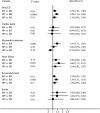Clinical outcomes of patients with hypothyroidism undergoing percutaneous coronary intervention
- PMID: 26757789
- PMCID: PMC4940453
- DOI: 10.1093/eurheartj/ehv737
Clinical outcomes of patients with hypothyroidism undergoing percutaneous coronary intervention
Abstract
Aims: The aim of this study was to investigate the association between hypothyroidism and major adverse cardiovascular and cerebral events (MACCE) in patients undergoing percutaneous coronary intervention (PCI).
Methods and results: Two thousand four hundred and thirty patients who underwent PCI were included. Subjects were divided into two groups: hypothyroidism (n = 686) defined either as a history of hypothyroidism or thyroid-stimulating hormone (TSH) ≥5.0 mU/mL, and euthyroidism (n = 1744) defined as no history of hypothyroidism and/or 0.3 mU/mL ≤ TSH < 5.0 mU/mL. Patients with hypothyroidism were further categorized as untreated (n = 193), or those taking thyroid replacement therapy (TRT) with adequate replacement (0.3 mU/mL ≤ TSH < 5.0 mU/mL, n = 175) or inadequate replacement (TSH ≥ 5.0 mU/mL, n = 318). Adjusted hazard ratios (HRs) were calculated using Cox proportional hazards models. Median follow-up was 3.0 years (interquartile range, 0.5-7.0). After adjustment for covariates, the risk of MACCE and its constituent parts was higher in patients with hypothyroidism compared with those with euthyroidism (MACCE: HR: 1.28, P = 0.0001; myocardial infarction (MI): HR: 1.25, P = 0.037; heart failure: HR: 1.46, P = 0.004; revascularization: HR: 1.26, P = 0.0008; stroke: HR: 1.62, P = 0.04). Compared with untreated patients or those with inadequate replacement, adequately treated hypothyroid patients had a lower risk of MACCE (HR: 0.69, P = 0.005; HR: 0.78, P = 0.045), cardiac death (HR: 0.43, P = 0.008), MI (HR: 0.50, P = 0.0004; HR: 0.60, P = 0.02), and heart failure (HR: 0.50, P = 0.02; HR: 0.52, P = 0.017).
Conclusion: Hypothyroidism is associated with a higher incidence of MACCE compared with euthyroidism in patients undergoing PCI. Maintaining adequate control on TRT is beneficial in preventing MACCE.
Keywords: Hypothyroidism; Major adverse cardiovascular and cerebral events; Percutaneous coronary intervention.
Published on behalf of the European Society of Cardiology. All rights reserved. © The Author 2016. For permissions please email: journals.permissions@oup.com.
Figures








Comment in
-
Should we screen for hypothyroidism in patients with cardiovascular disease?Eur Heart J. 2016 Jul 7;37(26):2066-8. doi: 10.1093/eurheartj/ehv694. Epub 2016 Jan 12. Eur Heart J. 2016. PMID: 26763791 No abstract available.
-
Evidence and controversies regarding the screening for subclinical hypothyroidism in patients with cardiovascular disease.J Thorac Dis. 2016 Jun;8(6):E446-50. doi: 10.21037/jtd.2016.04.20. J Thorac Dis. 2016. PMID: 27294253 Free PMC article. No abstract available.
References
-
- Kahaly GJ , Dillmann WH . Thyroid hormone action in the heart . Endocr Rev 2005. ; 26 : 704 – 728 . - PubMed
-
- Polikar R , Burger AG , Scherrer U , Nicod P . The thyroid and the heart . Circulation 1993. ; 87 : 1435 – 1441 . - PubMed
-
- Baumgartner C , Blum MR , Rodondi N . Subclinical hypothyroidism: summary of evidence in 2014 . Swiss Med Wkly 2014. ; 144 : w14058 . - PubMed
-
- Rugge JB , Bougatsos C , Chou R . Screening and treatment of thyroid dysfunction: an evidence review for the U.S. Preventive Services Task Force . Ann Intern Med 2015. ; 162 : 35 – 45 . - PubMed
-
- Boelaert K . Thyroid dysfunction in the elderly . Nat Rev Endocrinol 2013. ; 9 : 194 – 204 . - PubMed
MeSH terms
LinkOut - more resources
Full Text Sources
Other Literature Sources
Medical
Research Materials
Miscellaneous

